works: academic
Since 2024, I have been a student in Radboud University's Creative Industries MA Program. As part of this master's program, I have been able to critically engage with socio-cultural theory and artistic practice to produce a wide array of outputs. In my study, I have creatively built upon my undergraduate studies to create a stronger, more compelling body of work.
My present research interests: Cultural and environmental sustainability within the creative industries; nationalism and digital identities; gender and sexuality; durability and sustainable fashion; and Wagnerism.
Performance: Brain Storm
December 18th at the Erasmusgebouw, Radboud University
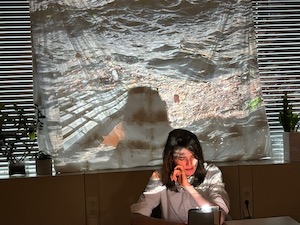
.
In collaboration with fellow Creative Industries student Stan Pol, we sought out to critcally explore the student experience in an age of disordered attention.
Concurrent crises of finance and housing, global disasters, human atrocity, and the looming climate crisis weigh down on students more than ever-- we found intrigue in cataloging these experiences but also discovering how students manufacture meaning to their lives, synthesizing their experiences of global citizen and student into one identity.
Our installation, featuring a soundscape composed by Stan alongside orginal visuals and an endurance performance undertaken by myself, presented a unique paradigm by which to present our research, while also further conducting it. Modeled after a classroom, often misattributed as a space independent from reality, we brough the outside world in and internal thoughts out. Attendees were then brought into a space where they cannot ignore this reality.
Overwhelmed by audiovisual stimuli we aimed to put our attendees into an almost anti-meditative state, whereupon they can glean insights about themselves and connection to academia and the world around them. We are interested in what people see in themselves whilst in our space and are actively collecting feedback from attendees to track the project's progress.
The performance too provided a subject for the audience to perceive and experience. The audience, alongside the performer, endures 3 hours non-stop of reading aloud prior academic work, facing the awkwardness, incorrectness, and perhaps meaninglessness of works produced. However, the audience is in a position of power or hopeful agency. They have the chance to leave, effectively stopping the cycle of despair, symbolically committing to hope and change.
Bringing Brain Storm to Life
Our Theory
CC: Our project first began after the second Sustainable Arts Education course when I approached Stan about the potential of doing a performance art piece as the cumulative project for our course. To flesh out the project, we wanted to make sure that theory was central to the work that we were doing-- and that we could meaningfully explore the concepts we have been learning about in a rather non-traditional context. Stan, who had recently read Claire Bishop's Disordered Attention, brought to the forefront her ideals of the reorganization of attention and spectatorship in contemporary culture which resonated with me.
At the beginning of our course, we had already readily spent hours discussing student stresses and frustrations, the inspiration as to why I wanted to embark on this process-- the text Stan brought seemingly crystallized these observations into a theory we could explore. Stan will go more into the theory of "disordered attention" in his section of this recap.
For the method of our performance, I found myself theoretically grounded within the ideals of the Fluxus movement. Fluxus, often described as a laboratory of creative ideals, is defined by its name-- flow and change. Fluxus sought to explore art as a process rather than a final product to be admired, criticized, and commercialized. Additionally, Fluxus found particular interest, as leader in the movement George Maciunas put it, in finding art in our everyday experiences.
Particular inspiration came to me in the form of Yoko Ono's performance work. For example, in 1964's Cut Piece at Carnegie Hall, Ono asked the seated audience one by one to come up and cut off a piece of her clothing until she sat naked. In this construction, the audience is both perceiving and acting, becoming part of the performance through their active participation within the work, but also their presence within the space. Microexpressions as to how one sits in the chair or reacts to the performance on stage become a part of the performance on the whole.
I identified this construction of performance art with the way that we exist in a classroom space-- how are we performing our studenthood? What can taking the ideals of Fluxus and Ono Not only when we interact with a teacher, but telegraph our studenthood in the way we carry ourselves to class, how we write, and how we ask and answer questions about our studies and the world? Especially keeping the radical origins of Fluxus in mind, how can we turn this "mundane" everyday process of the classroom into a critical art piece?
By using the framework of Fluxus and Ono's non-traditional presentation as a way to explore society critically through artistic practice-- Brainstorm was born.
SP: Claire Bishop examines how contemporary culture has reshaped attention and spectatorship, questioning traditional engagement models with art and knowledge. She critiques the Enlightenment-rooted “depth model of culture,” which values intellectual works for their supposed profundity and capacity to sustain exhaustive focus. In contrast, the performance described here rejects such ideals, instead highlighting the awkwardness, imperfection, and potential meaninglessness of academic texts created within today’s fractured attention economy.This model of fragmented attention reflects a reality where both the writer and the reader are only partially engaged, their focus constantly interrupted by the demands of multitasking and hybrid modes of labour that blend digital and physical realities.
The installation creates what Bishop describes as a “grey zone,” a conceptual space where traditional forms of artistic presentation (like the darkened theatre of experimental performance or the pristine art gallery) merge with contemporary technologies like smartphones. This convergence produces a hybrid mode of spectatorship that oscillates between physical presence and digital engagement.
This hybridity is evident in this performance as participants experience both sensory overload and the demand for sustained attention. The contradictions of being simultaneously present and distracted mirror how modern intellectual and artistic production often feels fragmented and destabilised by the pervasive distractions of digital culture.
Bishop also critiques how attention has been commodified to be “managed,” with strategies like mindfulness or “slow looking” held up as remedies to the overwhelming pace of life. The performance pushes back against these frameworks by refusing comfort or resolution. Instead, it immerses participants in discomfort and forces them to confront the fragmented nature of their engagement. When audience members choose to leave or stay, their actions symbolise the broader tension within the “attention economy,” where the focus is constantly fragmented, and disengagement can be reframed as an act of resistance or agency.
Through this lens, the performance exemplifies Bishop’s ideas by presenting a hybrid form of artistic engagement. It compels participants to rethink their relationship with academia, activism, and collective identity in a world where neither the creation nor reception of knowledge or art is ever fully intact or uninterrupted.
Our Creative Process and Task Division
As for the shared work we embarked on in our creative journey, we already spoke to the first part of the process-- that is the brainstorming sessions to flesh out our concept and theory. Over several extended meetings outside of the classroom and dedicated project time within class, we understood how we wanted the project to manifest and what we would explore through our research and artistic process. Once we came up with a joint concept and explicit research question-- we were able to embark on our respective creative journeys as we contributed work to the piece.
The research question we decided on was: How does one construct and perform their identity as a student in a time where more and more is being expected of students, as we struggle to study against the backdrop of financial and housing crises, job shortages, and uncertainty about the future of our very climate?
Once we decided on this question-- we set to tackle it through several creative outputs. Particularly, Stan's soundscape (constructed of as many students' stories as possible responding to our question), Caroline's performance, and the joint work we did to transform Erasmus 11.18a into an immersive experience.
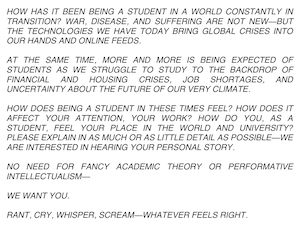
Snippet from our exhibition book with our explict call for stories
SP: My research phase took about 12 hours and was focused on the concept of disordered attention, which became the heart of our performance. Exploring this idea gave me a solid theoretical grounding and shaped the way the soundscape intertwined with the other elements of the project.
Preparing the audio was the most demanding part of the process, taking close to 60 hours. This involved transforming raw, phone-recorded testimonials—carefully gathered by Caroline—into high-quality, disordered sounds. It was painstaking work, but seeing it evolve into something immersive felt rewarding. Setting up the audio playback system was another challenge, requiring more hours of design and testing. The lack of professional speakers forced us to get creative. We hid two phones and two laptops to create a quad-speaker setup. It wasn’t conventional, but it worked beautifully, surrounding the audience with the chaotic, overwhelming soundscape we had envisioned.
Reaching out to professors and the Radboud University marketing department also took a few hours, but it was worth it. The professors were incredibly supportive, even offering tips to broaden our outreach. Caroline complemented these efforts by hanging posters beautiful posters.
Caroline took charge of most of the pre-and post-production tasks. She spent hours preparing the video projection and ensuring everything worked seamlessly while I focused on the technical aspects of the audio. Her work collecting testimonials added so much depth to the project. She found over an hour of material, which allowed me to craft a non-repeating, three-hour soundscape. Her video projection, filled with thought-provoking questions and constantly in motion, fit perfectly with the audio, creating a layered and cohesive experience.
Caroline also designed the pamphlet, which was beautifully put together. Although we ran out of time to perfect the final booklets, the pamphlet captured the essence of the project and helped audiences understand its meaning.
Throughout the process, we kept in close contact. Regular meetings and constant updates via text helped us stay aligned in our artistic and academic visions. We balanced the workload well. Caroline took on more tasks early, while my responsibilities increased during production. We both had our hands full as the project came together, but it always felt like a true partnership. We never thought we were doing more or less than the other.
One of my biggest lessons was how challenging it is to bring an immersive artistic performance into a university setting. Coming from an art education background, I was used to having more freedom to create projects like this. At the university, we had to work with limited resources, which pushed us to be inventive. The result was a stripped-down installation where every detail was intentional and impactful.
Looking back, I’m proud of what we accomplished together. The project wasn’t just about disordered attention but collaboration, resourcefulness, and finding ways to blend theory with practice. It showed me how art can provoke meaningful discussions and bridge the gap between academia and creative expression.
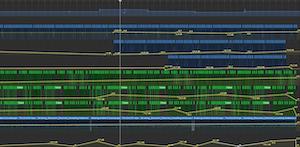
Screenshot of part of Stan's audio editing timeline
Stan's Audio
CC: For my portion of the work, I was heavily focused on pre-production support for Stan, actively performing the piece, and post-production as I presently assemble this blog post (which I am physically coding in HTML).
For the preproduction process, I focused heavily on conceptualizing the project and developing our research question. Before I even reached out to Stan about collaboration-- I knew that performance was the path I wanted to explore. Knowing I couldn't do the project by myself, I first dedicated about 10 hours of conceptualization and research into Fluxus, Ono, and performance art to develop a proof of concept for Stan. Luckily, he agreed to join the project!
After hours of joint meetings, we developed actionable tasks to work on in preparation for the December 18th performance. Chief of all in pre-production was Stan's soundscape, on which Stan meticulously spent hours. I am amazed and inspired by his creative drive and technical know-how. As Stan handled the audio, I supported him by procuring interview audio for him and completing other technicalities related to the project-- such as editing video media, designing and hanging posters, and assembling our exhibition guide.
Specifically, in procuring the raw material that Stan would need for his audio architecture, I conducted qualitative interviews. We were interested in how we could interweave the stories of fellow students into the soundscape Stan was composing. Through a call for stories disseminated amongst group chats and social media and in-person field interviews, I captured raw audio from interested persons in the project. By obtaining this audio we got to understand more intimately the student experience across a large sample, rather than Stan and I's own experiences. This process took about another 10 to 12 hours of my time.
We informed interviewees of the project's purpose and how their audio would be used. After outlining this in all calls for stories, a physical submission of an audio recording or verbal consent to be recorded was considered their permission to use the audio (and its transcripts) for the project. These audio interviews that we obtained consitute in part some of our findings.
Ultimately, I gathered for Stan around an hour of raw audio from 11 respondents. I was amazed at Stan, who meticulously interwove sounds of nature, samples from video games, and the stories of our interviewees into a 3-hour long non-repeating symphony of stimuli.
I am proud of my role as a producer for the project. Alongside the audio procurement process for Stan, I additionally spent a good 25 hours working on the video editing process of the project. To create the looping, multilayered film projected during the performance, I carefully selected footage that was relevant to the project and spliced it together. Keeping in line with Bishop's "disordered attention," I kept the clips as short as possible and very overwhelming. However, the shorter the clips, the longer the editing process becomes.
I also designed, printed, and distributed posters across campus, which took half a day. From Huygens to Maria Montessori-- it was hard to ignore what we were cooking up. On the day of the performance, I also assembled an exhibition guide. Due to the last-minute nature of the printing and stapling, the booklets were not well put together; however, the content was well-edited and complemented our exhibition well. This is a part of the project I would like to return to, should we reexhibit.
The Exhibition Guide
However, my most notable contribution to the creative process was my physical endurance performance. For three hours straight, I pushed myself to the limit as I read old academic writings of mine spanning from 2018 to 2024. Alongside me, the audience could perceive the physical changes in my body as a result of the performance. The more tired I became, the more mistakes I made in my reading, my eyesight worsened due to the continual reading and the burning light of the projector, and most perceptibly, I lost my voice. However, what was more interesting were the psychological changes I felt.
First, I had no perceivable understanding of the passage of time or even the people who came to the exhibition--I was utterly transfixed by what I was reading. The entire experience went by quickly, I had no way to tell the time so it passed quickly. The longest portion of the day was when Stan told me that I had 30 minutes left to read, the other two and a half hours passed without barely a care. In those last 30 minutes, the pain became very real. I noticed the pain in my body and in my voice, my vision fuzzier.
As for attendees, I had no understanding of who entered the room. The only presence I could slightly identify was that of Stan, who floated around the room in a single domineering position. We had discussed early on the conception that maybe he would play the role of a teacher. In the feedback we received attendees seemed interested in his role, so I am elated that Stan performed the piece with me-- even if his manifestation of endurance was different than mine. He is such a crucial part of the journey.
One thing I remember from the moment is that I found much of my old writing meaningless, if not embarrassing when read aloud. Looking back on old writing with a critical eye, I severely doubted my ability as a student. I questioned whether or not I had wasted years of my time as a student writing imperfection. Are there not more important things in my life and this world to focus on? However, I could not tarry long on these thoughts. I had to stay focused on the task at hand, getting on the other side of three hours. The experience at the desk and of those perceiving the performance provided an intimate exploration of our research question.
Once I could return to earth after the performance, I could finally return to my struggle with meaninglessness. I could reckon with the fact that my previous writings were just stepping stones-- why was I holding myself, as a learning student, to such standards of immaculate perfection? That everything I have ever written need to pass the test of oration and performance? I remembered a lesson from an English class I had when I was 14-- the name essay comes from essayer, "to attempt" in French. Despite what external pressures may face students, perfection is something the vast majority of us will never achieve. Why are we degrading the student experience of exploration and development?
At the end of the project, I found myself being able to give myself grace. To trust the process and recenter the fact that I am not a perfect product educating myself for the sake of a diploma, but rather to improve my craft and hone my voice. Specifically, from orating a rather complete span of my writings, I was able to explore how I found my voice. Without this performance, I am not sure if I would have the same appreciation. I am also intrigued at how the audience was able to embark on this journey with me, however, I will discuss this more in the section where I critically review the project and explore the feedback we received.
The film that Caroline created for projection.
Our Product
Brain Storm occurred on December 18th, 2024, in the Faculty of Art's exhibition space in 11.18a in Radboud University's Erasmusgebouw. Conceived, researched, and performed by Caroline Couch and Stan Pol, the piece sought to be a new approach to the arts education research happening within the Creative Industries Masters program in a method and manner never before seen at this university. The multi-media art exhibition/installation was a skillful balance of academic, technical, and artistic creativity.
The space was prepared to foster an almost anti-meditative state-- where unnerving stimuli overwhelmed the audience. We achieved this through audio, visual, and structural means.
-
Audio: As discussed, Stan masterfully composed a 3-hour soundscape featuring ambient noise, unsettling samples, and the jumbled, collective musings of fellow students as they responded to our research question. Having fantastic audio is one thing, however, we needed the audio to sound immersive in the space without access to a multi-channel speaker system. Stan, being a masterful audio engineer, researched ways to simultaneously broadcast the audio across multiple electronics in the space to create both volume and depth. We settled on SonoBus, which allowed us to link our electronic devices (2 laptops and 3 phones) to broadcast the audio seamlessly.
After testing the levels and tracking the audio, we hid the devices around the exhibition space. Some were in plain sight, others hidden in bookcases or underneath audience member's chairs. By having these different devices hidden around the space, we created a depth of sound that immersed audiences within the space. In some places, the audio was more overwhelming, in other spaces, one channel of the multi-layered audio became more apparent. Using Stan's technological resourcefulness and Caroline's experience with sonic and art installations-- we were able to create a compelling audio experience without the need for fancy speakers.
While not technical, Caroline's performance added overall to the sonic experience. The oration of the papers, while various in their topics and language, remained the most sonically consistent piece of the performance. However, unlike Stan's audio which gained in intensity without fail-- Caroline's ability to project and speak waned over the three hours providing an interesting contrast in auditory intensity. Additionally, the continual stream of new information from Caroline provided another dimension for audiences to attempt to parse in the sea of stimuli. -
Visual: Visually, audience members were also overwhelmed with stimuli. Though not mapped out to the same length and precision as the audio-- they were a carefully designed and executed portion of the exhibit. The projected film, though appearing to be just a continual stream of useless information, was full of references, intentional imagery, and unsettling questions.
In no particular order, the film included, in part: snippets of news clips featuring stories of climate change, political unrest, and financial crisis from across the world and every EU member state; protest imagery and policy language from the present educational budget cut saga in the Netherlands; cultural references and memes native to Gen Z; the text of Johnathan Swift's "A Modest Proposal" contrasted to reports of present global famine; global Indigenous resistance; concerns by climate and health scientists as to the state of our planet; and thought-provoking rhetorical questions related to one's attention
The presence of exhibition guides in the installation space also provided another piece of visual material for audience members and a challenge. The guide allowed us to summarize our artistic goals and provide full transcripts of some of the stories heard over the audio. However, it provided another challenge to our audience members' attention-- could they focus on the guide while also being exposed to the other overwhelming stimuli? Feedback showed that the answer was in fact, yes. -
Structural: The structure of our performance was also extremely important as we created a unique space. We shifted around the exhibition class to mimic that of a classroom. Caroline playing the role of the student's outward appearance and inner stress; Stan, the silent and observing teacher, or perhaps a person of authority more sinister and restrictive than a hopefully guiding academic. This relationship between performers is one that we hope to explore further in any future re-performances of the work.
While there was inevitably a structured divide between the audience and performers, we tried our best to lower this threshold. There were no restrictions on where audience members could exist within the space. Some sat next to the performer, many stuck towards the back. By structuring the space to be as open as possible while retaining the look and feel of a classroom, we were able to get across our points about education while also observing how the individual audience members constructed themselves within our performance, seeing how they would place themselves in the space and react to the content of the instillation.
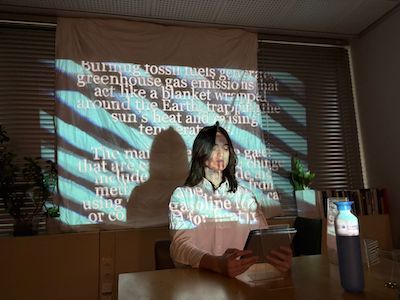
Image from the performance
Our Critical Reflections on Feedback
We have just as many critiques about our project as successes. However, we see the critiques not as singular shortfallings but rather as areas we can improve upon in future projects. Luckily, to obtain our audience's perspective, we had a feedback form. Many responses overlap with issues we have already intimated earlier in this report. In this section, we will go over them again.
Stans's role as the teacher came up in discussions we had after the exhibit and explicitly in some of the feedback that we received. While some interpreted Stan immediately as a teacher, others found his role, while domineering and perpetually observing, a little more muddied. Did he represent a teacher, an academic superstructure, or in the case of the gender divide-- perhaps gender-based discrimination, as the power imbalance widened the more Caroline's "pain" was physically realized?
While Stans's role was not an afterthought-- it was not a concept we had fully fleshed out. Rather, it is merely one that we had discussed and considered, but not factored in entirely into the performance. Yes, Stan intentionally dressed as a teacher. However, his primary role during the performance was to ensure the technical success of the audio and film and capturing archival stills and videos. Yet, as time progressed, he adopted more and more of an intentional character-- observer, voyeur, and potential academic. This is something he leaned into. In future performances, we agree that we would need to flesh out this "teacher" character more in a way that would benefit the performance and more readily come across to audiences. Additionally, to facilitate the addition of this silent character, we would need to have a non-performing technician on the creative team to ensure that the audio/visual media runs smoothly.
Another piece of feedback we received was that the exhibition was too stimulating. This means that we achieved in our quest of overwhelming our audience, however, our feedback suggested that the glut of stimulation prevented some from gleaning further reflection on the piece. Some got lost in the overwhelming space and interpreted our message as one of hopelessness-- rather than providing stimulus for deeper reflection and change. While we structurally hoped that leaving the exhibit would feel like a commitment to change, some perceived exit as a defeated retreat. For future performances, a solution could be offering some sort of artist-talk back or lecture about the project to bring it into wider conversation amongst those in our academic community.
While we had an artist's statement, it was objectively, and intentionally, hard to read within the space. Perhaps there is a way in future project iterations to have more messages of hope or direct references to our goal in our audio and visuals. Having this lecture or talk back also goes in line with another reflection we have on the project-- we wish that we had more feedback! However, it is understandable that many audience members were probably too distracted/overstimulated to respond to our form after the experience. Additionally, since the performance was the last day before the break for most Creative Industries students, many who intended to leave a review likely forgot to once the holiday mindset set in.
The final reflection that we have upon our work is that we would have benefited more from a little more time and technology on our side. Our performance was, no doubt, a little rough around the edges and this DIY nature performed some charm and authenticity. However, we agree that in future performances we would like more time to prepare exhibition materials and the spaces to have a little more of a professional nature. Ideally, next time it would be amazing to perform the work in an actual classroom space. Higher-quality speakers and multiple projectors would also allow for a better audio/visual experience with more depth. For example, our diy speaker setup relied on having a strong WiFi connection. When we had a large group of audience members come in, the audio quality notably dropped as they all joined the WiFi. If we had a proper wired speaker system, we wouldn't have to have unexpected dips in audio quality again.
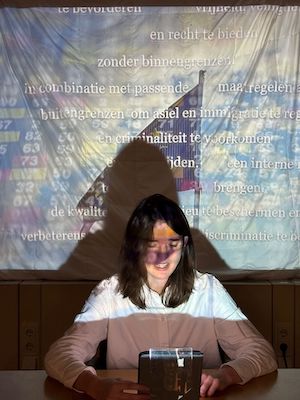
Image from the performance
Conclusions
In summary, we are very proud of the project we created. We believe that we not only synthesized new knowledge and artistic concepts through the collection and arrangement of student stories into a storm of audio and visual stimuli-- but also presented such findings through a new medium to Radboud University. We believe that the exhibit was thought-provoking and exciting to attendees. While not perfect, the feedback we received is actionable and provides a solid foundation for fine-tuning our project rather than completely reworking it. We both agree that this is one of the most exciting projects we have undertaken in an academic context, and we are extremely thankful to have had the chance to bring Brain Storm to life.